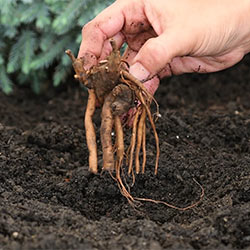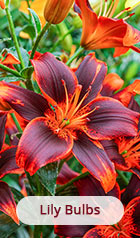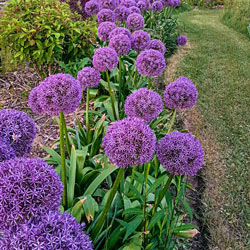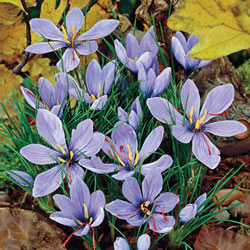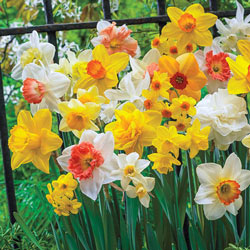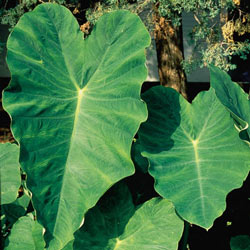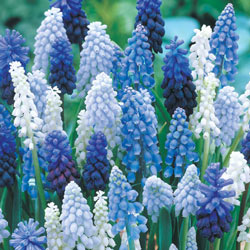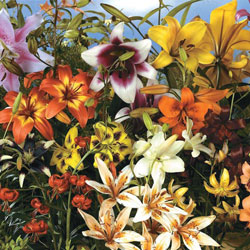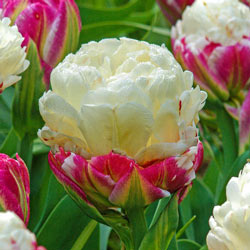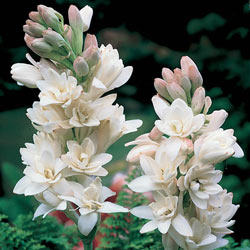Thank You!
We have received your request. You will be notified when this product is in stock.
X
Flowering bulbs are incredibly easy to grow, and with a little water and patience, you'll have gorgeous plants in no time. Also, these plants will bring color and texture to your garden throughout the entire season. Don't miss out on bringing beauty and variety to your landscape with our products. Shop our selection of flower bulbs for sale now!
What are flower bulbs?
Let's start with the basics: what are flower bulbs? In botanical terms, a bulb is usually a globe-shaped, underground bud with a short stem with fleshy leaves that grow out of it. The flower bulb stores energy during the dormant period of the plant's life. Onions and shallots are considered bulbous plants -- their life force is stored in the bulb, which is what we eat. Flowering bulbs are similar in nature. Their bulbs contain the starts of thick-leaved plants that will also sprout beautiful flowers.
Many of our favorite springtime flowers, like tulips, daffodils, hyacinths, snowdrops, crocuses, allium, grape hyacinth, and fritillaria, are planted as bulbs in the fall. Because the bulbs contain the blueprints and energy of the dormant plants, ornamental bulbs can survive shipping better than actively blooming plants. That's one of the reasons flower bulbs for sale online are available for shipping to a wide variety of locations!
Some ornamental bulbs are planted in the spring, for summer and fall flowers. These include Asiatic and Oriental lilies, dahlias, peonies, gladiolus, begonias, caladiums, cannas, callas, elephant ears, autumn crocuses, and hyacinths. Some of these bulbs, like dahlias and calla lilies, grow in more of a tuberous style. Instead of the onion-shaped bulb, these bulbs will look like potatoes -- they sprout from eyes. Some flower tubers are hardy through the winter, and some require lifting. However, tuberous plants are similar to bulbs in that they store the plant's energy through the dormant season, and allow it to sprout back to life at the right time of the year.
Flower bulbs can also be "forced" to bloom indoors, even during the cold months. Indoor growers capitalize on bulbs' natural tendency to sprout and bloom when given warmth and water after a period of dormancy. Narcissus, amaryllis, and even traditionally springy flowers like tulips and crocuses can be grown indoors in this fashion.
When to plant flower bulbs:
Spring-flowering bulbs, like tulips, daffodils, and hyacinths, need to be planted in the fall. These flower bulbs can be planted in October or November — giving them time to settle into their locations before the winter. In colder climates (Zones 4 through 7), spring-flowering bulbs can be planted once the weather drops below 40 degrees Farenheight, and before the ground freezes. If you live in a warmer climate, you'll need to chill those bulbs in the refrigerator for several weeks as the ground cools down.
Summer flowering bulbs can be planted in the spring, often as soon as the ground thaws. Some bulbs, like autumn crocuses, can be planted while the ground is still cold. However, most tender bulbs don't appreciate being frozen, or even being particularly cold! For tender tubers like begonias, callas and dahlias, you should wait until all threat of frost has passed, and the ground is significantly warmed. That may be May or even June in colder climates.
When to plant flower bulbs indoors:
Lots of spring-flowering bulbs can be forced indoors, but the difficulty level definitely depends on the type of plant. Narcissus bulbs, like paperwhites, and amaryllis can be forced indoors, and make wonderful winter decor. You'll need to check the length of time between planting and blooming for your specific variety, but these types of flower bulbs can generally be planted in a pot of soil with indirect light and produce flowers in two to eight weeks.
Spring-blooming bulbs, like tulips, irises, and daffodils, can also be forced indoors: but, they require a chilling period to mimic winter. You can replicate that cooling period by storing those flower bulbs in the refrigerator for about four months before planting them. Some gardeners even keep a rotation of bulbs in the fridge, so that as some bloom, another set chill out and get ready for an indoor "spring!"
How to store flower bulbs
Some flowers, like dahlias and cannas, need to be lifted in the fall to avoid freezing. Once you lift those bulbs, wipe them off and leave them in the sun to dry for several days, or even a week. You'll also want to trim off their dying leaves: dirt or leafy matter can collect fungus and pests.
Once the flower bulbs are dry, gently place them in a box with a dry material like peat moss or packing peanuts, or use layers of brown paper or paper bags to separate them. Store the bulbs with the eyes on tubers or pointed end of bulb facing up and the roots facing down, and leave some space between the bulbs.
How long can flower bulbs be stored? Summer-flowering flower bulbs should typically only be stored for the cold season—they may not bounce back after spending a full year in storage. Fall-planted bulbs can be stored during the summer, until it's time to plant.
However, if spring rolls around and you find bulbs you forgot to plant in the fall, go ahead and get them in the ground, as long as they don't appear to be rotted or totally dried out. Your flower bulbs will probably sprout, but may spend their first year a bit stunted.
How to plant flower bulbs
When you plant flower bulbs, you need to make sure they'll be in a location where they'll thrive. Most bulbs prefer loamy, well-drained soil and partial shade to full sun (check your bulbs for specifics). In general, you should plant bulbs two to three times as deep as the bulbs are tall. This means most large bulbs like tulips or daffodils will be planted about 6 inches deep while smaller bulbs, like crocus, will be more shallow.
Lasagna planting is one popular means of ensuring a year's worth of in-season blooms. Because not all bulbs flower at the same time, some gardeners layer their spring and summer bulbs as they plant them. Plant big, spring-blooming bulbs on the bottom layer, add a second layer of summertime bulbs, and do a third of smaller, early-spring or late summer bulbs. This way, your garden will have plenty of color all season long!
